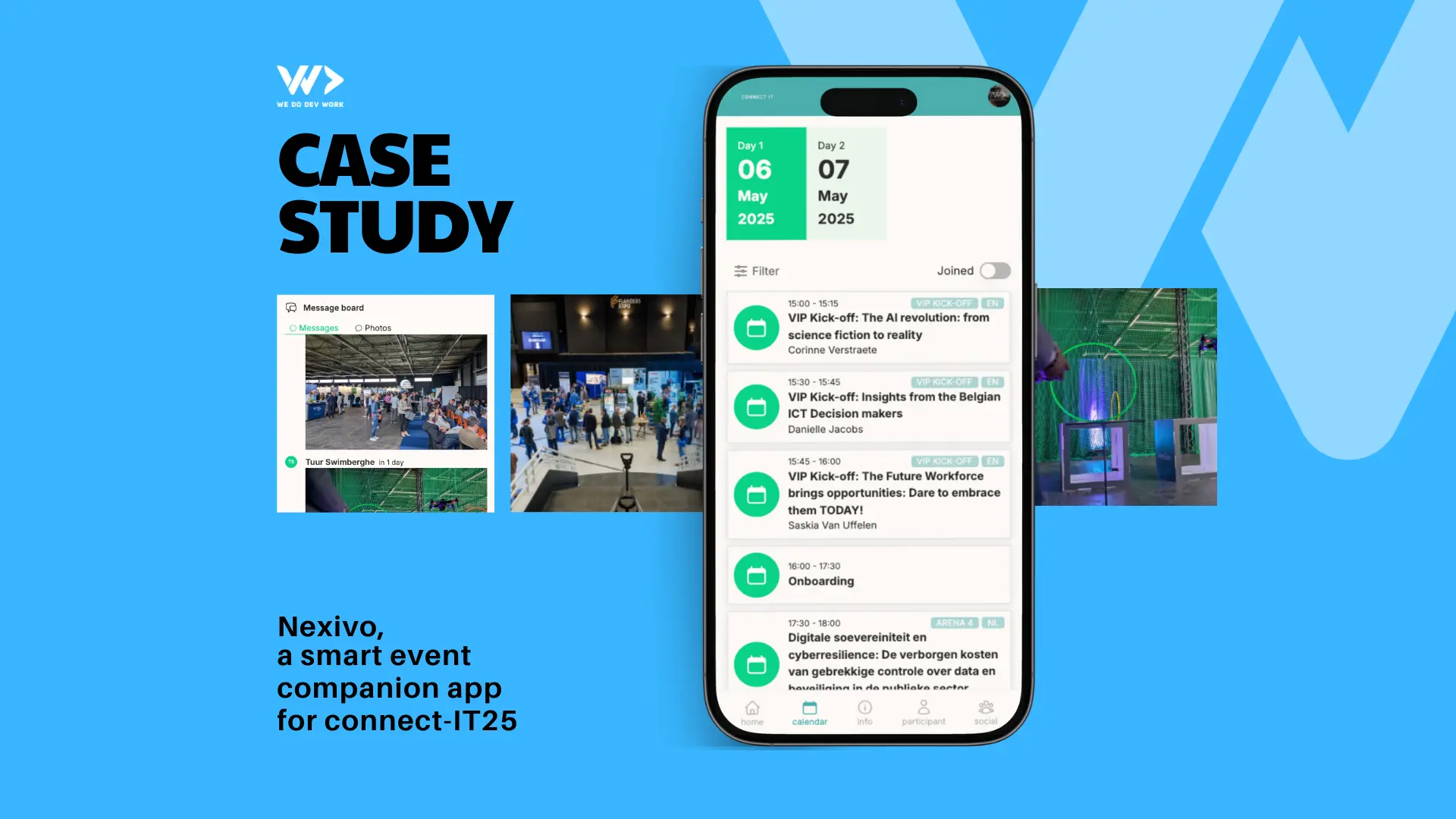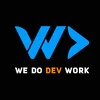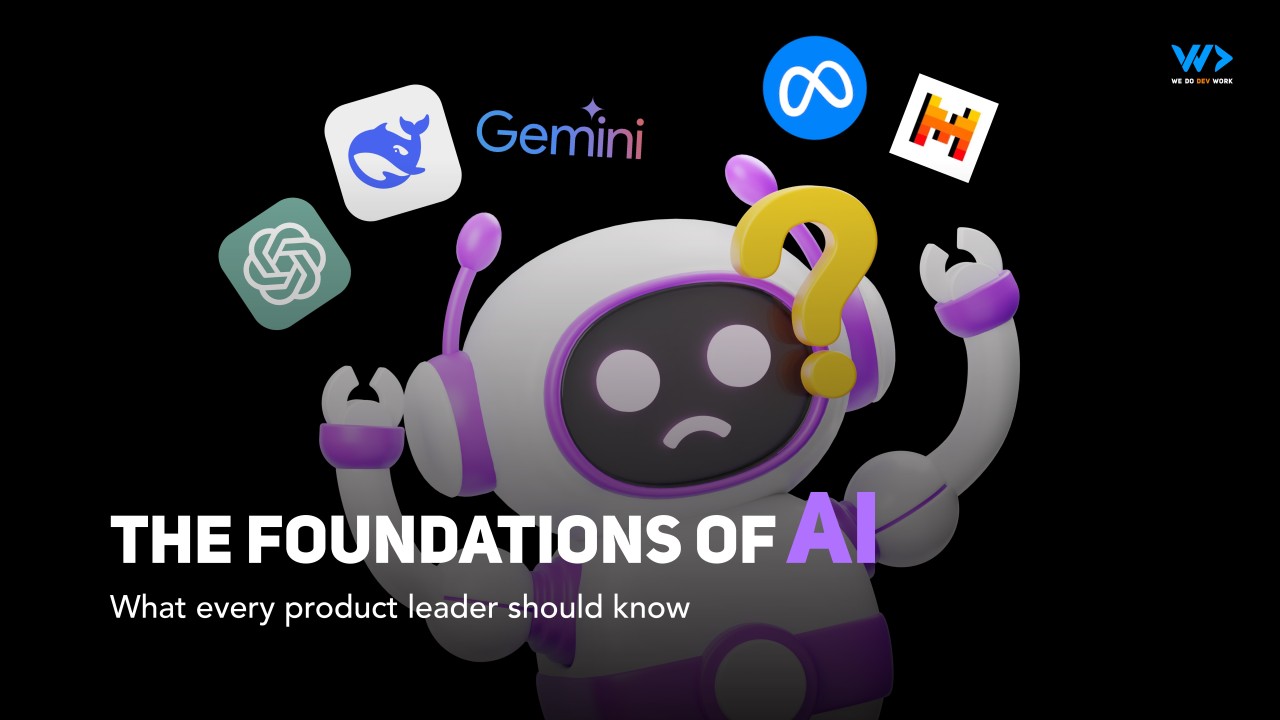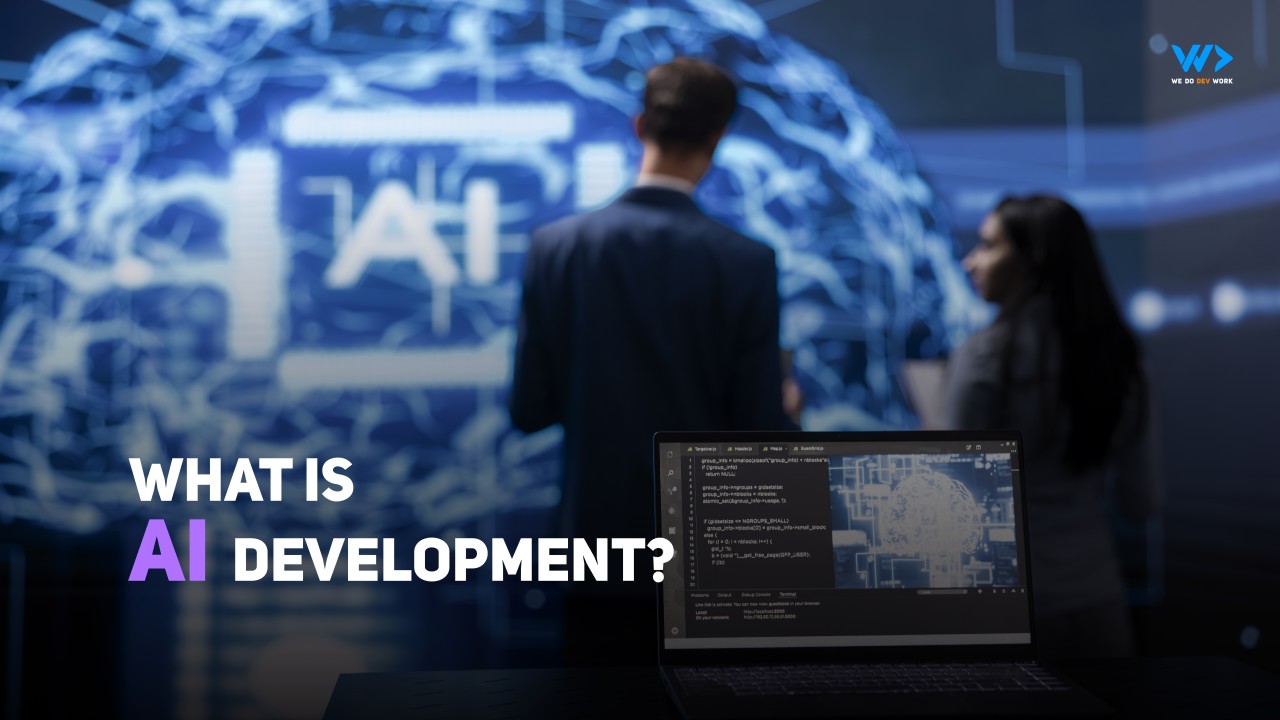
Case study: Nexivo, a smart event companion app for Connect-IT25

At We Do Dev Work, we specialize in building tailored software solutions that solve real-world challenges. When we partnered with the organizers of Connect-IT25, we were tasked with building an app that would enhance the attendee experience in a meaningful way. The result was Nexivo, an intuitive event companion app designed to help visitors navigate the venue, create their own schedules and connect with other attendees in real-time.
With a tight timeline of 5 weeks, we immediately put our design team to work. We came up with detailed wireframes that allowed us to discuss and finalize a clear scope in just a few days. Knowing what was expected, we started designing the application user experience and interfaces. Fortunately for us, Connect-IT25 already had an established brand identity, which made it possible for us to mostly focus on the user experience of the app.
Because of the tight timeline, we simultaneously worked on the technical architecture while the UI designs were being finalized. Our engineering team needed to come up with a scalable foundation that could handle hundreds of attendees without leaving them waiting for a response.
After just one week of design and architecture, our development team started writing the app. It may be of no surprise that there were still features that needed to be refined while being developed. With our agile development approach however, we could quickly switch between redesigning a feature and moving it back into development.
Within just 3 weeks, we had a testable solution hosted on a beta environment which Connect-IT25 used to give valuable feedback. That gave us 2 weeks to polish up the application and even add additional features! Resulting in a clean, finalized delivery right before the event took place.
Due to our careful planning, focusing our design making on what matters to the users, taking the right choices in our technology stack and an agile approach in our development phase, we were able to build Nexivo from scratch in just 5 weeks and over-deliver! Let’s dive a bit deeper into the choices we made, and why.
Design choices
Before jumping into design, we made it a priority to first understand the needs of both event attendees and organizers. Our research phase had to be quick, but laser-focused. We combined user insight, competitor analysis, and rapid wireframing to move from ideas to execution efficiently.
Here's how we approached it
Step 1 - Gathering Requirements from the client: Our process began with a detailed discovery session with the organizer.
Step 2 - Internal Team Discussion & Scoping: With input from the organizers in hand, we conducted collaborative workshops with our product, design, and developers teams.
Step 3 - Competitive Analysis: To better understand industry standards and user expectations.
Step 4 - Wireframing: We used low-fidelity wireframes in Figma to map out key flows and layouts before moving to high-fidelity UI.
Step 5 - Design Decisions: based on our research, the following design principles shaped the final UI:
Minimalist navigation: Just 5 bottom tabs—Home, Calendar, Info, People, and Social
Context-first home screen: Showing important information, current and upcoming sessions with quick actions.
Visual hierarchy: Session times, room info, and speaker names are easy to scan at a glance
This structured research process helped us move quickly while staying user-focused. Ensuring Nexivo was not only built fast, but built right.
While Nexivo was designed for Connect-IT25, we knew from the start that the app needed to be reusable across future events: each with its own unique branding, colors, and visual identity. To solve this, we built Nexivo on top of a flexible design framework that could adapt easily to any corporate identity (CI) without changing the core structure of the app. We implemented a theming structure that allows organizers to plug in primary & secondary brand colors and typography preferences. All components such as buttons, cards, navbars, and tabs follow consistent spacing and layout rules and use tokens for padding, color, and font sizes.
Moreover, one of Nexivo’s core strengths is how easy it is to use, real-time interaction between attendees. It’s just like what you'd find in modern communication platforms. We introduced a dedicated Social tab in the bottom navigation, which includes two tools: Community and Direct Message. The Community feature offers channel-based conversations for open discussion and experience sharing. Direct Messaging allows users to connect privately, making relationships and networking more meaningful.
Tech choices
Key architectural decisions included which backend to use, which frontend framework to use and where to deploy the application. We had a few important constraints to take into consideration:
The app needs to serve many users at the same time
We need mobile support
Frameworks and tech choices should support quick development
So, with these constraints in mind, we came up with the following choices.
Since our backend has to support authentication, websockets, regular CRUD of events and user related information and file storage, we decided to go for Supabase. Supabase is an open source backend that ships with a bunch of our needed features already. That’s a big perk, because by using what comes out of the box, we save a bunch of time that would traditionally be needed for writing auth handlers, file uploads, APIs etc. Supabase can be self-hosted, but we chose to subscribe to a cloud hosted plan so we wouldn’t have to manage infrastructure, again saving time that can be used for other development.
For our frontend, we first made the choice to build a PWA rather than using either a native or platform agnostic mobile framework. We knew the users would pretty much only be on mobile devices, but to speed up development we would need a platform agnostic framework. That’s why we could quickly rule out native kotlin and swift development. We did then end up choosing for a PWA, because of the way the authentication system is supposed to work: users would receive an email with a token that lets them log in to the platform. Having a PWA would let the user login immediately, without having to be redirected to an app store first to then download it, go back to the email and click the link again.
We chose NextJS to build this PWA, server side rendering gives us some flexibility on how we render the app. We can cache data on the server to speed up load times, giving the users a smooth and app-like experience. Pages can be pre-fetched, already populated with the event and profile information, again contributing to an amazing performance. Since we’re very familiar with NextJS at We Do Dev Work, we could quickly ship features and have time left for optimizations.
For our frontend hosting, we chose to deploy on AWS Amplify, largely due to the built in CDN configuration and deployment pipelines. It also auto-scales out of the box, reducing the need for us to manage any critical infrastructure.
However, not everything got handed to us using this tech stack, there were some minor issues along the way. These are the lessons we learned:
- The kind of token we required for authentication wasn’t a traditional one time magic link, we had to develop our own time based token that was usable during the entire event. This gave our users the ability to open the app in a different browser or multiple times during the day.
- Another common issue we ran into was that opening the keyboard in the chat interface wouldn’t properly resize the PWA, which we resolved by adding custom resize handlers. This wouldn’t be an issue when working with a native framework.
- Server side rendering adds a layer of complexity to building an application, we spent a lot of time optimizing performance that could have been spent developing features. We’re happy with the result, but this was only achievable due to our extensive experience with NextJS already.



